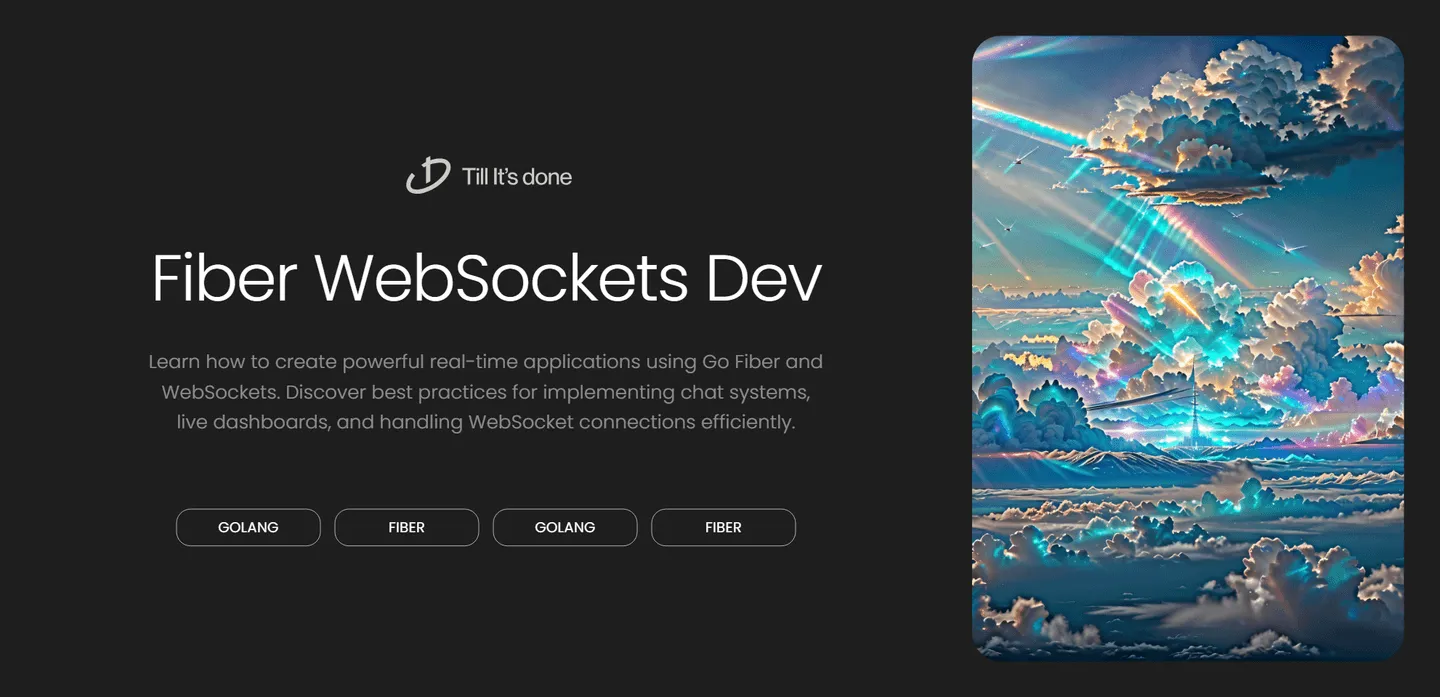- Services
- Case Studies
- Technologies
- NextJs development
- Flutter development
- NodeJs development
- ReactJs development
- About
- Contact
- Tools
- Blogs
- FAQ
Building Real-time Apps with Fiber & WebSockets
Discover best practices for implementing chat systems, live dashboards, and handling WebSocket connections efficiently.

Building Real-time Applications with Fiber and WebSockets

Real-time applications have become an essential part of modern web development. Whether you’re building a chat application, live dashboard, or collaborative tool, WebSocket technology enables instant, bidirectional communication between clients and servers. In this article, we’ll explore how to create powerful real-time applications using Go Fiber and WebSockets.
Why Fiber and WebSockets?
Fiber is a fast, lightweight web framework for Go that’s inspired by Express.js. Its excellent performance characteristics and developer-friendly API make it an ideal choice for building real-time applications. When combined with WebSockets, you can create responsive applications that provide instant updates to your users.
Setting Up the Project
Let’s start by creating a simple real-time chat application. First, we’ll need to set up our project and install the necessary dependencies:
go mod init realtime-appgo get github.com/gofiber/fiber/v2go get github.com/gofiber/websocket/v2
Basic WebSocket Server Implementation
Here’s a basic implementation of a WebSocket server using Fiber:
package main
import ( "log" "github.com/gofiber/fiber/v2" "github.com/gofiber/websocket/v2")
type Client struct { IsAlive bool Conn *websocket.Conn}
var clients = make(map[*Client]bool)
func main() { app := fiber.New()
app.Use("/ws", func(c *fiber.Ctx) error { if websocket.IsWebSocketUpgrade(c) { return c.Next() } return fiber.ErrUpgradeRequired })
app.Get("/ws", websocket.New(func(c *websocket.Conn) { client := &Client{IsAlive: true, Conn: c} clients[client] = true
defer func() { delete(clients, client) client.Conn.Close() }()
for { messageType, message, err := c.ReadMessage() if err != nil { break }
// Broadcast message to all clients for client := range clients { if client.IsAlive { if err := client.Conn.WriteMessage(messageType, message); err != nil { client.IsAlive = false delete(clients, client) } } } } }))
log.Fatal(app.Listen(":3000"))}Handling Real-time Events
One of the key aspects of real-time applications is handling events efficiently. Let’s explore how to manage different types of events in our application:

type Message struct { Event string `json:"event"` Content string `json:"content"`}
func handleMessage(message []byte, clients map[*Client]bool) { var msg Message if err := json.Unmarshal(message, &msg); err != nil { return }
switch msg.Event { case "chat": broadcastMessage(message, clients) case "typing": notifyTyping(msg.Content, clients) case "presence": updatePresence(msg.Content, clients) }}Best Practices and Considerations
When building real-time applications with Fiber and WebSockets, keep these best practices in mind:
- Implement heartbeat mechanisms to detect disconnected clients
- Use connection pooling to manage WebSocket connections efficiently
- Implement proper error handling and recovery mechanisms
- Consider scaling strategies for handling large numbers of concurrent connections
- Implement authentication and authorization for WebSocket connections
- Use proper message serialization and validation
Conclusion
Building real-time applications with Fiber and WebSockets opens up exciting possibilities for creating interactive and responsive web applications. The combination of Fiber’s performance and WebSocket’s real-time capabilities provides a solid foundation for developing modern web applications.

 สร้างเว็บไซต์ 1 เว็บ ต้องใช้งบเท่าไหร่? เจาะลึกทุกองค์ประกอบ website development cost อยากสร้างเว็บไซต์แต่ไม่มั่นใจในเรื่องของงบประมาณ อ่านสรุปเจาะลึกตั้งแต่ดีไซน์, ฟังก์ชัน และการดูแล พร้อมตัวอย่างงบจริงจาก Till it’s done ที่แผนชัด งบไม่บานปลายแน่นอน
สร้างเว็บไซต์ 1 เว็บ ต้องใช้งบเท่าไหร่? เจาะลึกทุกองค์ประกอบ website development cost อยากสร้างเว็บไซต์แต่ไม่มั่นใจในเรื่องของงบประมาณ อ่านสรุปเจาะลึกตั้งแต่ดีไซน์, ฟังก์ชัน และการดูแล พร้อมตัวอย่างงบจริงจาก Till it’s done ที่แผนชัด งบไม่บานปลายแน่นอน  Next.js สอน 14 ขั้นตอนเบื้องต้น: สร้างโปรเจกต์แรกใน 30 นาที เริ่มต้นกับ Next.js ใน 14 ขั้นตอนเพียงแค่ 30 นาที พร้อม SSR/SSG และ API Routes ด้วยตัวอย่างโค้ดง่าย ๆ อ่านต่อเพื่อสร้างโปรเจ็กต์แรกได้ทันทีที่นี่
Next.js สอน 14 ขั้นตอนเบื้องต้น: สร้างโปรเจกต์แรกใน 30 นาที เริ่มต้นกับ Next.js ใน 14 ขั้นตอนเพียงแค่ 30 นาที พร้อม SSR/SSG และ API Routes ด้วยตัวอย่างโค้ดง่าย ๆ อ่านต่อเพื่อสร้างโปรเจ็กต์แรกได้ทันทีที่นี่  วิธีสมัคร Apple Developer Account เพื่อนำแอปขึ้น App Store ทีละขั้นตอน อยากปล่อยแอปบน App Store ระดับโลก มาอ่านคู่มือสมัคร Apple Developer Account พร้อมเคล็ดลับ TestFlight และวิธีอัปโหลดที่ง่ายในบทความเดียวนี้ได้เลย
วิธีสมัคร Apple Developer Account เพื่อนำแอปขึ้น App Store ทีละขั้นตอน อยากปล่อยแอปบน App Store ระดับโลก มาอ่านคู่มือสมัคร Apple Developer Account พร้อมเคล็ดลับ TestFlight และวิธีอัปโหลดที่ง่ายในบทความเดียวนี้ได้เลย  TypeScript Interface คืออะไร? อธิบายพร้อมวิธีใช้และข้อแตกต่างจาก Type เรียนรู้วิธีใช้ TypeScript Interface เพื่อสร้างโครงสร้างข้อมูลที่ปลอดภัยและเข้าใจง่าย พร้อมเปรียบเทียบข้อดีข้อแตกต่างกับ Type ที่คุณต้องรู้ ถูกรวมเอาไว้ในบทความนี้แล้ว
TypeScript Interface คืออะไร? อธิบายพร้อมวิธีใช้และข้อแตกต่างจาก Type เรียนรู้วิธีใช้ TypeScript Interface เพื่อสร้างโครงสร้างข้อมูลที่ปลอดภัยและเข้าใจง่าย พร้อมเปรียบเทียบข้อดีข้อแตกต่างกับ Type ที่คุณต้องรู้ ถูกรวมเอาไว้ในบทความนี้แล้ว  Material-UI (MUI) คืออะไร อยากสร้าง UI สวยงามและเป็นมืออาชีพในเวลาอันรวดเร็วใช่ไหม มาทำความรู้จักกับ Material-UI (MUI) ที่ช่วยให้คุณพัฒนาแอปพลิเคชันบน React ได้ง่ายและดูดีในทุกอุปกรณ์
Material-UI (MUI) คืออะไร อยากสร้าง UI สวยงามและเป็นมืออาชีพในเวลาอันรวดเร็วใช่ไหม มาทำความรู้จักกับ Material-UI (MUI) ที่ช่วยให้คุณพัฒนาแอปพลิเคชันบน React ได้ง่ายและดูดีในทุกอุปกรณ์  เปรียบเทียบ 3 วิธีติดตั้ง install node js บน Ubuntu: NVM vs NodeSource vs Official Repo แบบไหนดีที่สุด? เรียนรู้วิธีติดตั้ง Node.js บน Ubuntu ด้วย NVM, NodeSource หรือ Official Repo เลือกวิธีที่เหมาะกับความต้องการของคุณ พร้อมเปรียบเทียบ เพื่อการพัฒนาที่มีประสิทธิภาพ!
เปรียบเทียบ 3 วิธีติดตั้ง install node js บน Ubuntu: NVM vs NodeSource vs Official Repo แบบไหนดีที่สุด? เรียนรู้วิธีติดตั้ง Node.js บน Ubuntu ด้วย NVM, NodeSource หรือ Official Repo เลือกวิธีที่เหมาะกับความต้องการของคุณ พร้อมเปรียบเทียบ เพื่อการพัฒนาที่มีประสิทธิภาพ! พูดคุยกับซีอีโอ
We'll be right here with you every step of the way.
We'll be here, prepared to commence this promising collaboration.
Whether you're curious about features, warranties, or shopping policies, we provide comprehensive answers to assist you.


